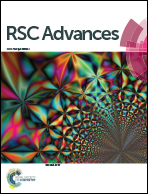High-performance flexible dye-sensitized solar cells by using hierarchical anatase TiO2 nanowire arrays†
Abstract
Pioneering products in wearable technologies, such as Apple Watch, Google Glass or Nike smart sneakers, are leading a new trend in electronic devices. However, the fast developing field of wearable electronics urgently demands lightweight and flexible/bendable energy supplying devices. Here, we present thin, lightweight and flexible dye-sensitized solar cells (DSSCs) using three different kinds of TiO2 nanostructures grown on Ti meshes as photoanodes. The flexible DSSCs based on hierarchical anatase TiO2 nanowire arrays exhibit a higher power conversion efficiency (1.76%) than those based on TiO2 nanotube arrays (1.52%) or TiO2 nanowire arrays (0.85%). This enhancement can be attributed to (1) the large surface area and (2) the low recombination rate of electrons and the redox electrolyte. Moreover, commercial ink has been identified as a promising alternative to fabricate a flexible counter electrode and the corresponding DSSCs achieve a considerable conversion efficiency of 1.59%. The as-fabricated mesh based DSSC retains 88% of its PCE after bending for 300 cycles, demonstrating its good flexibility and fatigue resistance. In addition, the as-fabricated sealed DSSCs have been integrated to light LEDs, which demonstrates that our flexible DSSCs are promising candidates for wearable/flexible energy supplying devices in everyday applications.


 Please wait while we load your content...
Please wait while we load your content...